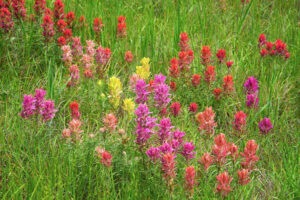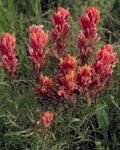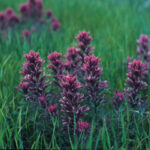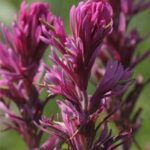 by CMG Betty J
by CMG Betty J
Ferdinand Lindheimer catalogued many Texas native species. Many bear his name within their Latin nomenclature, lindheimeri. One of the flowers that blooms in the same season as the Texas Bluebonnet, the Lindeimer’s Prairie Paintbrush, Castilleja purpurea var lindheimeri, provides lovely red contrasting color to those blue flowers.  They are also known as Indian Paintbrush, Downy Indian Paintbrush, Purple Paintbrush and Purple Painted Cup. The genus was named for the Spanish botanist Domingo Castillejo.
They are also known as Indian Paintbrush, Downy Indian Paintbrush, Purple Paintbrush and Purple Painted Cup. The genus was named for the Spanish botanist Domingo Castillejo.
These herbaceous perennial flowers differentiate themselves from the common prairie paintbrush in that they sport floral bracts in shades of pink and orange along with the typical reds. They grow to 18” in some cases on hairy, green stems. The leaves grow in one to three pairs with narrow, lateral lobes.

 This species is native to the calcareous grasslands from Southern Kansas to south Texas. It differs from the more familiar, annual Castilleja species in that it has a longer lifespan and a wider range of colors. The three natural varieties feature bracts ranging from yellow to orange and red and purple, depending on the variety. The variety purpurea, Prairie Paintbrush, has the widest range of natural colors, usually some shade of purple, but occasionally, also shades of red, orange, yellow, or white. It is semi-parasitic on grass roots, making it a good candidate for meadow and prairie planting.
This species is native to the calcareous grasslands from Southern Kansas to south Texas. It differs from the more familiar, annual Castilleja species in that it has a longer lifespan and a wider range of colors. The three natural varieties feature bracts ranging from yellow to orange and red and purple, depending on the variety. The variety purpurea, Prairie Paintbrush, has the widest range of natural colors, usually some shade of purple, but occasionally, also shades of red, orange, yellow, or white. It is semi-parasitic on grass roots, making it a good candidate for meadow and prairie planting.

Native Americans used the blooms as a condiment with other greens and some tribes made a hair wash from them. The high concentration of selenium in the plants may have accounted for their use as an arthritis treatment by some native peoples.